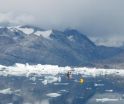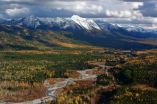(Press-News.org) Wheat fields are often tilled immediately after the crop is harvested, removing the light-coloured stubble and crop residues from the soil surface and bringing dark bare earth to the top. Post-harvest tilling is a widely practised and common management technique in Europe. However, ploughed fields can have a negative effect on the local climate during a heat wave. This effect was addressed in a recent study conducted by researchers at ETH Zurich led by Edouard Davin, senior lecturer at the Institute for Atmospheric and Climate Science, and Sonia Seneviratne, professor of land-climate dynamics, which has now been published in the scientific journal PNAS.
Unploughed stubble is lighter in colour and reflects more solar radiation than tilled surfaces. Measurements taken show that approximately 30% of sunlight is reflected back due to the albedo effect – the albedo is a measure of the reflectance capacity of reflective surfaces. Ploughed fields reflect only 20% of incoming solar radiation. Model simulations have shown that this difference results in a 50% higher level of reflection in unploughed fields and that this in turn has a significant effect in extreme heat. In the event of a heat wave, such as the one in Europe in 2003, unploughed farm fields could reduce the local temperature by as much as 2 °C.
Regional effect
The hotter it becomes, the greater the albedo effect and the resulting temperature reduction. "Cropland albedo management has more effect during heat waves because there is almost no clouds during these events and more radiation can be reflected back into space", says first author Edouard Davin. However, this effect is only short term and local — perhaps at the most regional, but never trans-regional.
"In other words, if all French farmers were to stop ploughing up their fields in summer, the impact on temperatures in Germany would be negligible," says Seneviratne. Leaving fields untilled would also have no noticeable effect over the long term on global warming trends and more frequent heat waves. Nevertheless, as Seneviratne points out, the local impact is important and could help break peak temperatures on extremely hot days.
Overall, says Seneviratne, no-till farming makes more sense in regions where summers are regularly very hot due to high levels of sun exposure e.g. in areas around the Mediterranean. Nonetheless, on heat days, the effect is also relevant in Central and Northern Europe. As part of the study, which was carried out jointly by the ETH researchers and French scientists, Davin analysed solar radiation measurements on farmland near the southern French city of Avignon. The researchers also conducted model simulations for Europe that incorporated the projected effect of unploughed cropland.
The scientists also report that the cooling effect of an unploughed field cannot be attributed solely to changes in albedo values. Crop residue acts as an insulating layer that holds back moisture from deeper soil strata and releases it only slowly — this long process of evaporation also helps reduce the air temperature during a heat wave. In a ploughed field, on the other hand, moisture evaporates more rapidly and almost completely in extreme heat. Thus, there is an additional cooling effect of no-till farming through slow evaporation.
No-till farming common in the Americas
The researchers believe no-till farming is a useful option in order to mitigate the local effects of climate change — for example, on extremely hot days in summer. "It is important that cropland albedo management can dampen heat waves because these events, although rare by definition, have a large impact on humans and ecosystems," Seneviratne explains. Even though the rise in average global temperatures has stagnated in recent years, there has been an increase in extreme heat events over land areas.
Europe in particular has sufficient potential to use no-till farming as a tool to lower temperatures on hot days. Until now, European farmers have left only an extremely small portion of their fields unploughed after a harvest and globally the region accounts for only 2% of all unploughed cropland. The situation is very different in the US and South America, which account for 85% of the world's unploughed farmland.
INFORMATION:
References
Davin EL, Seneviratne SI, Ciais P, Olioso A and Wang T. Preferential cooling of hot extremes from cropland albedo management. PNAS Early Edition, published online 23 June 2014. DOI: 10.1073/pnas.1317323111
Straw albedo mitigates extreme heat
2014-06-23
ELSE PRESS RELEASES FROM THIS DATE:
Vaccine made from complex of two malaria proteins protects mice from lethal infection
2014-06-23
WHAT:
An experimental vaccine designed to spur production of antibodies against a key malaria parasite protein, AMA1, was developed more than decade ago by scientists from the National Institute of Allergy and Infectious Diseases (NIAID), part of the National Institutes of Health. It showed promise in test-tube and animal experiments and in early-stage clinical trials, but returned disappointing results in recent human trials conducted in malaria-endemic countries.
Now, the NIAID scientists have improved on their original vaccine with a new candidate that delivers AMA1 ...
Rett syndrome drug shows promise in clinical trial
2014-06-23
CAMBRIDGE, MA -- Rett syndrome, a rare genetic disorder that causes mental retardation, autism, and physical deformities, has no cure. However, a small clinical trial has found that a growth factor known as IGF1 can help treat some symptoms of the disease.
Children who received the drug for four weeks showed improvements in mood and anxiety, as well as easier breathing, in a trial led by researchers at Boston Children's Hospital. MIT scientists first identified IGF1 as a possible treatment for Rett syndrome in 2009.
"This trial shows that IGF1 is safe in the cohort ...
New analysis reveals previously 'hidden diversity' of mouth bacteria
2014-06-23
MBL, WOODS HOLE, MA—A new computational method for analyzing bacterial communities has uncovered closely related, previously indistinguishable bacteria living in different parts of the human mouth. The technique, developed by Marine Biological Laboratory (MBL) scientists, provides high taxonomic resolution of bacterial communities and has the capacity to improve the understanding of microbial communities in health and disease. The study will be published in PNAS Online Early Edition the week of June 23-27, 2014.
An important step in understanding the role of oral bacteria ...
Computational technique provides new insight into oral microbiome
2014-06-23
CAMBRIDGE, Mass., June 23, 2014—Scientists have applied a new technique to comprehensively analyze the human oral microbiome—providing greater knowledge of the diversity of the bacteria in the mouth. For the first-time, scientists can provide high-resolution bacterial classification at the sub-species level. This work will enable researchers to more closely examine the role of bacterial communities in health and disease.
The study, "Oligotyping analysis of the human oral microbiome," will be published in the Proceedings of the National Academy of Sciences and available ...
Delivering drugs on cue
2014-06-23
June 23, Boston -- Current drug-delivery systems used to administer chemotherapy to cancer patients typically release a constant dose of the drug over time - but a new study challenges this "slow and steady" approach and offers a novel way to locally deliver the drugs "on demand," as reported in the Proceedings of the National Academy of Sciences (PNAS).
Led by David J. Mooney, Ph.D., a Core Faculty member at Harvard's Wyss Institute for Biologically Inspired Engineering and the Robert P. Pinkas Family Professor of Bioengineering at the Harvard School of Engineering ...
Bone loss persists 2 years after weight loss surgery
2014-06-23
CHICAGO, IL — A new study shows that for at least two years after bariatric surgery, patients continue to lose bone, even after their weight stabilizes. The results—in patients undergoing gastric bypass, the most common type of weight loss surgery—were presented Monday at the joint meeting of the International Society of Endocrinology and the Endocrine Society: ICE/ENDO 2014 in Chicago.
"The long-term consequences of this substantial bone loss are unclear, but it might put them at increased risk of fracture, or breaking a bone," said Elaine Yu, MD, MSc, the study's principal ...
A disease of mistaken identity
2014-06-23
The symptoms of Cushing disease are unmistakable to those who suffer from it – excessive weight gain, acne, distinct colored stretch marks on the abdomen, thighs and armpits, and a lump, or fat deposit, on the back of the neck. Yet the disorder often goes misdiagnosed.
To help combat misdiagnosis, Saleh Aldasouqi, an associate professor in the College of Human Medicine at Michigan State University, is drawing more attention to the rare disease through a case study, which followed a young patient displaying classic, yet more pronounced signs of the condition.
Caused ...
Date labeling confusion contributes to food waste
2014-06-23
Date labeling variations on food products contribute to confusion and misunderstanding in the marketplace regarding how the dates on labels relate to food quality and safety, according to a scientific review paper in the July issue of Comprehensive Reviews in Food Science and Food Safety. This confusion and misunderstanding along with different regulatory date labeling frameworks, may detract from limited regulatory resources, cause financial loss, and contribute to significant food waste.
In the United States, the United States Department of Agriculture Economic Research ...
Understanding the ocean's role in Greenland glacier melt
2014-06-23
The Greenland Ice Sheet is a 1.7 million-square-kilometer, 2-mile thick layer of ice that covers Greenland. Its fate is inextricably linked to our global climate system.
In the last 40 years, ice loss from the Greenland Ice Sheet increased four-fold contributing to one-quarter of global sea level rise. Some of the increased melting at the surface of the ice sheet is due to a warmer atmosphere, but the ocean's role in driving ice loss largely remains a mystery.
Research by scientists at Woods Hole Oceanographic Institution (WHOI) and the Univ. of Oregon sheds new light ...
Protecting and connecting the Flathead National Forest
2014-06-23
A new report from the Wildlife Conservation Society (WCS) calls for completing the legacy of Wilderness lands on the Flathead National Forest in Montana. The report identifies important, secure habitats and landscape connections for five species—bull trout, westslope cutthroat trout, grizzly bears, wolverines, and mountain goats. These iconic species are vulnerable to loss of secure habitat from industrial land uses and/or climate change.
Located in northwest Montana adjacent to Glacier National Park, the 2.4 million-acre Flathead Forest is a strategic part of the stunning ...




